WE ALL travel difficult journeys at some stage in our lives, experiences which test our resilience and capacity for survival. So too in the natural world, animals and birds make difficult and dangerous journeys.
Mass migrations have already begun around us as tens of thousands of wildfowl and waders have left their breeding haunts of far northern Europe and arrived in Ireland and Britain to spend the winter feeding in the loughs, fields and tidal mudflats along our coasts.
Cold eastern winds will soon carry to our shores the winter thrushes, fieldfare and redwing from Scandinavia and northern Russia to feed on our softer pastures, fruits and berries. All are driven here by the same ancient genes which draw them northwards and eastwards again when the urge to breed returns in spring.
I came upon an unexpected creature one night recently which highlighted the dangers faced by migrating animals. Outside my garage on the oblong paving stones a great diving beetle (Dytiscus marginalis), was burrowing and struggling with its oar-like arms and legs to find safe hiding. An intricately evolved but ferocious predator of ponds and lakes, this aquatic insect had been on the wing, seeking out some of the small local inland loughs before becoming disorientated by the jungle of urban brickwork and street lighting.
Because they use the reflection of the moon to navigate the night skies in search of new water sources, these beetles are often found on wet roads or other hard, wet surfaces. Now out of its natural habitat it was vulnerable.
The great diving beetle, (Ciaróg phortaigh in Irish – bog beetle) true to its name, is a sizeable insect. The elongated, short-tempered larvae, often known as water tigers, can grow up to 6cm in length, while the oval-shaped adults are about 3.5cm long.They live in fresh water, either still or slow-running, preferring water with vegetation.
Darkly coloured with blackish-green on their back and wing cases, known as elytra, and yellow on their underside and legs, the adult male's wing cases are smooth and shiny, while those of the larger female are finely grooved, markings clearly evident on my visitor.
The dytiscus, coming from the Greek dytikos 'able to dive', hunts a wide variety of prey including tadpoles, small invertebrates and fish. Their sharp jaws inject enzymes that digest their prey so that the juices can be ingested by the beetle. The larvae hunt by holding still, waiting with jaws wide open, and then strike suddenly, clutching the prey tightly with their jaws. As with the adults, the pincers are hollow, enabling them to begin sucking the juices of their prey while grasping it.
The hind legs of the adult are fringed with hairs and flattened especially for swimming. They can often be seen rising to the surface of ponds and upending to collect air under their wing cases for breathing, before diving downwards again. Larvae also take air from the surface of the water using hairs at the end of their abdomen.
Having examined and admired this beautifully adapted insect between my thumb and forefinger, I raised my hand skyward and thrust her into the night, wishing her a fair wind for the onward journey in search of water and safety. I hope that come spring, she will, along with her mate, be patrolling the depths of some fertile pond searching for an errant tadpole with, as English nature poet John Clare wrote about them, their 'jetty jackets glittering in the sun'.



